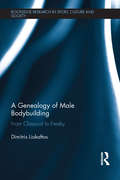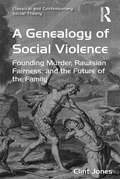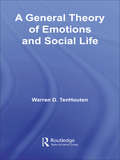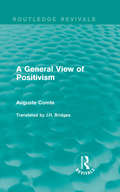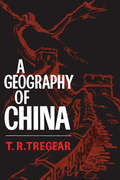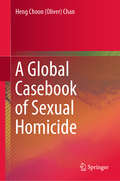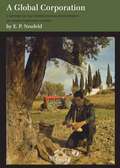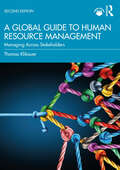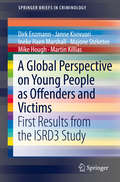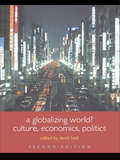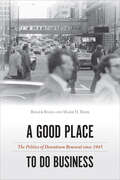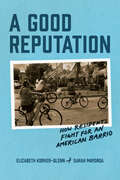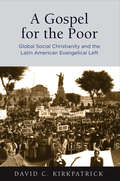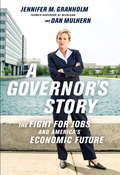- Table View
- List View
A Genealogy of Male Bodybuilding: From classical to freaky (Routledge Research in Sport, Culture and Society)
by Dimitris LiokaftosBodybuilding has become an increasingly dominant part of popular gym culture within the last century. Developing muscles is now seen as essential for both general health and high performance sport. At the more extreme end, the monstrous built body has become a pop icon that continues to provoke fascination. This original and engaging study explores the development of male bodybuilding culture from the nineteenth century to the present day, tracing its transformations and offering a new perspective on its current extreme direction. Drawing on archival research, interviews, participant observation, and discourse analysis, this book presents a critical mapping of bodybuilding’s trajectory. Following this trajectory through the wider sociocultural changes it has been a part of, a unique combination of historical and empirical data is used to investigate the aesthetics of bodybuilding and the shifting notions of the good body and human nature they reflect. This book will be fascinating reading for all those interested in the history and culture of bodybuilding, as well as for students and researchers of the sociology of sport, gender and the body.
A Genealogy of Self-Interest in Economics
by Uskali Mäki Susumu Egashira D. Wade Hands Masanori TaishidoThis is the first book to describe the entire developmental history of the human aspects of economics. The issue of “self-interest” is discussed throughout, from pre-Adam Smith to contemporary neuroeconomics, representing a unique contribution to economics. Though the notion of self-interest has been interpreted in several ways by various schools of economics and economists since Smith first placed it at the heart of the field, this is the first book to focus on this important but overlooked topic. Traditionally, economic theory has presupposed that the core of human behavior is self-interest. Nevertheless, some economists, e.g. recent behavioral economists, have cast doubt on this “self-interested” explanation. Further, though many economists have agreed on the central role of self-interest in economic behavior, each economist’s positioning of self-interest in economic theory differs to some degree. This book helps to elucidate the position of self-interest in economic theory. Given its focus, it is a must-read companion, not only on the history of economic thought but also on economic theory. Furthermore, as today’s capitalism is increasingly causing people to wonder just where self-interest lies, it also appeals to general readers.
A Genealogy of Social Violence: Founding Murder, Rawlsian Fairness, and the Future of the Family (Classical and Contemporary Social Theory)
by Clint JonesExamining the mimetic theory of René Girard, this book investigates the development of society as a result of an original crime (a murder) that shaped the way the earliest humans organized the social structures we live with today - an analysis that reveals the dangerous structure of the most basic social relationships. With attention to family relationships, A Genealogy of Social Violence sheds light on the processes by which the traditional nuclear family, through the mimetic behaviour of children, embeds violence into human desires and hence society as whole. Challenging the thought of Girard and of Rawls in order to offer a new understanding of justice, this book suggests that in order to achieve a more peaceful society, what is required is not the self-defeating narrative of equality, developed in order to manage the violence engendered by our social institutions, but a reconceptualisation of the nuclear family structure. A striking critique of modern society, which draws on religion, mythology, literature, history, philosophy and political theory, A Genealogy of Social Violence will be of interest to social and political theorists, as well as philosophers working in the area of contemporary social and European thought.
A General Theory of Emotions and Social Life (Routledge Advances in Sociology)
by Warren D. TenHoutenFounded upon the psychoevolutionary theories of Darwin, Plutchik and Izard, a general socioevolutionary theory of the emotions - affect-spectrum theory - classifies a wide spectrum of the emotions and analyzes them on the sociological, psychological and neurobiological levels. This neurocognitive sociology of the emotions supersedes the major theoretical perspectives developed in the sociology of emotions by showing primary emotions to be adaptive reactions to fundamental problems of life which have evolved into elementary social relationships and which can predict occurrences of the entire spectrum of primary, complex secondary, and tertiary emotions. Written by leading social theorist Warren D. TenHouten, this book presents an encyclopaedic classification of the emotions, describing forty-six emotions in detail, and presenting a general multilevel theory of emotions and social life. The scope of coverage of this key work is highly topical and comprehensive, and includes the development of emotions in childhood, symbolic elaboration of complex emotions, emotions management, violence, and cultural and gender differences. While primary emotions have clearly defined valences, this theory shows that complex emotions obey no algebraic law and that all emotions have both creative and destructive potentialities.
A General Theory of Magic (Routledge Classics)
by Marcel MaussFirst written by Marcel Mauss and Henri Humbert in 1902, A General Theory of Magic gained a wide new readership when republished by Mauss in 1950. As a study of magic in 'primitive' societies and its survival today in our thoughts and social actions, it represents what Claude Lévi-Strauss called, in an introduction to that edition, the astonishing modernity of the mind of one of the century's greatest thinkers. The book offers a fascinating snapshot of magic throughout various cultures as well as deep sociological and religious insights still very much relevant today. At a period when art, magic and science appear to be crossing paths once again, A General Theory of Magic presents itself as a classic for our times.
A General View of Positivism: Large Print (Routledge Revivals)
by Auguste ComteIn Comte’s original work on positivism, he attempted to outline a general perception of positivism, how it can be applied to society and how society would work should positivism be applied. J.H. Bridges’ translation, originally published in 1865, this version first published in 1908, manages to simplify and clarify Comte’s views of positivism and how it is related to the thoughts, feelings and actions of humankind as well as how positivism can be applied to philosophy, politics, industry, poetry, the family and the future. This title will be of interest to students of sociology and philosophy.
A Genre Approach to Celebrity Politics
by Nahuel RibkeExploring the transition of celebrities into institutional-electoral politics, the book argues that many insights developed by genre theorists could be highly instrumental to understand the celebrity politics phenomenon. It analyzes the historical and cultural specificity of celebrity politics as it evolved through different countries and cultures.
A Gentle Introduction To Stata
by Alan C. AcockAcock assumes that the user is not familiar with any statistical software. This assumption of a blank slate is central to the structure and contents of the book. Acock starts with the basics; for example, the part of the book that deals with data management begins with a careful and detailed example of turning survey data on paper into a Stata-ready dataset on the computer. When explaining how to go about basic exploratory statistical procedures, Acock includes notes that will help the reader develop good work habits. This mixture of explaining good Stata habits and good statistical habits continues throughout the book.
A Geographical Guide to the Real and the Good
by Robert SackFirst published in 2003. Routledge is an imprint of Taylor & Francis, an informa company.
A Geography Of Time: On Tempo, Culture, And The Pace Of Life
by Robert N. LevineIn this engaging and spirited book, eminent social psychologist Robert Levine asks us to explore a dimension of our experience that we take for granted--our perception of time. When we travel to a different country, or even a different city in the United States, we assume that a certain amount of cultural adjustment will be required, whether it’s getting used to new food or negotiating a foreign language, adapting to a different standard of living or another currency. In fact, what contributes most to our sense of disorientation is having to adapt to another culture’s sense of time. Levine, who has devoted his career to studying time and the pace of life, takes us on an enchanting tour of time through the ages and around the world. As he recounts his unique experiences with humor and deep insight, we travel with him to Brazil, where to be three hours late is perfectly acceptable, and to Japan, where he finds a sense of the long-term that is unheard of in the West. We visit communities in the United States and find that population size affects the pace of life--and even the pace of walking. We travel back in time to ancient Greece to examine early clocks and sundials, then move forward through the centuries to the beginnings of ”clock time” during the Industrial Revolution. We learn that there are places in the world today where people still live according to ”nature time,” the rhythm of the sun and the seasons, and ”event time,” the structuring of time around happenings(when you want to make a late appointment in Burundi, you say, ”I’ll see you when the cows come in”). Levine raises some fascinating questions. How do we use our time? Are we being ruled by the clock? What is this doing to our cities? To our relationships? To our own bodies and psyches? Are there decisions we have made without conscious choice? Alternative tempos we might prefer? Perhaps, Levine argues, our goal should be to try to live in a ”multitemporal” society, one in which we learn to move back and forth among nature time, event time, and clock time. In other words, each of us must chart our own geography of time. If we can do that, we will have achieved temporal prosperity.
A Geography of China
by T.R. TregearThis book is intended primarily for serious students of geography but it will also appeal to the general reader. For this reason technical terms have been used as sparingly as is consistent with correct meaning. Wherever the subject matter permits, the author emphasizes geographical growth and shows the interaction of geographical environment and the human activity and institutions. When originally published in the 1960s China was beginning to change with breathtaking rapidity. These changes are presented here against geographical and historical background. Knowledge of the environmental facts is essential to an appreciation of the political, economic, and social problems that have faced the Chinese people.
A Global Casebook of Sexual Homicide
by Heng Choon ChanThis book comprehensively discusses 13 infamous cases of serial and non-serial sexual homicide committed around the globe in the past four decades (1974–2010). Offering a psycho-criminological perspective, it analyzes the cases theoretically (i.e., contributing and precipitating factors, and offender typology) and considers the practical implications (i.e., investigative and crime-preventive measures, and social services). The first book to offer a glimpse of this topic from a global perspective, it adopts a unique approach—case background and critical analysis. As such it is a valuable source of reference for scholars, clinicians, and law enforcement practitioners wanting to gain a better understanding of this type of violent offender.
A Global Corporation: A History of the International Development of Massey-Ferguson Limited
by Edward Neufeld<p>The international or multi-national corporation has become an important phenomenon in today's business world and Massey-Ferguson is an ideal example of such an organization. Through its predecessor companies it can train its history to 1847, and so it has encountered virtually all the difficulties and developments of the last hundred years in business organization and management science. The development has not been straightforward for it has been much more than the growth of a single company in an expanding market. Management reorganization and the introduction of new management planning and control teachniques contributed a good deal to the company's expansion, and because mergers played a vital role, the history of other companies is also involved. <p>Dr. Neufeld's study concentrates on the years after the Second World War, a period in which the company's international operations became increasingly complex. He records the events that helped to shape the company's character and structure, and at the same time investigates the company's successes and failures in adjusting to a changing national and international business environment. His study reveals why Massey-Ferguson developed into a global corporation, an organization that considers the whole of the international environment when making decisions relating to the allocation of its marketing, purchasing, manufacturing and engineering activities.</p>
A Global Guide to Human Resource Management: Managing Across Stakeholders
by Thomas KlikauerA Global Guide to Human Resource Management is a concise HRM introductory text offering a uniquely non-region-specific approach to people management in international business organisations. The book presents an alternative to standard managerial approaches, reflecting the perspectives of multiple stakeholders (workers, trade unions, states and governments, NGOs) to critically evaluate HRM in practice and, in so doing, enables students to make effective decisions in their own practice, wherever their careers take them. Its accessibility and concision make it well suited to short courses for non-HRM and non-business specialists. This text covers all major introductory topics for non-specialists, introducing the concept and purpose of HRM, through recruitment, people, skills, designing work, promoting health, rewarding success, and successful and ethical people management. This edition includes a new chapter on green HRM. Rich with pedagogical features, the book includes five case studies per chapter to connect theory with practice. It is also supported with a range of instructor materials including online guest lectures, general discussion questions, a glossary, an index, and online documentaries that explain how to manage people. It is essential reading for students interested in Human Resources and Personnel Management, Organisational Behaviour and Development and Workplace Culture.
A Global Idea: Youth, City Networks, and the Struggle for the Arab World
by Mayssoun SukariehA Global Idea outlines how youth—as shown by the Arab Spring uprisings and subsequent state responses—became a prominent social and political category during the first two decades of the twenty-first century in the Middle East. Drawing on ethnographic fieldwork, interview data, and textual analysis, Mayssoun Sukarieh explains that the spread of youth as an important category is linked to the operation of a "global youth development complex," a diverse transnational network of state, private sector, civil society, and international development aid organizations that worked through key urban areas such as Washington, DC, Amman, and Dubai. In its analysis of the arrival, extension, and embedding of the youth development complex in the Middle East during this period, A Global Idea addresses a broader question that is of global and not just regional concern. How are certain ideas that are central to the working and reproduction of global capitalism able to travel the world so that they are found virtually everywhere?
A Global Perspective on Young People as Offenders and Victims: First Results from the ISRD3 Study (SpringerBriefs in Criminology)
by Martin Killias Ineke Haen Marshall Majone Steketee Dirk Enzmann Janne Kivivuori Mike HoughThis Brief presents the first major release of findings from the Third International Self-Report Delinquency Study (ISRD3). ISRD is a major international research collaboration that now covers some 35 countries. It surveys young people aged 12 to 16 in their schools, asking about their experience of crime - both as offenders and as victims - and about their attitudes to crime and justice and about their home and school life. ISRD1 was carried out in 1991-1992 and ISRD2 in 2006-2008. ISRD findings presented here cover the 27 ISRD3 countries for which data are already available, with a total sample approaching 63,000 young people. For most of these countries, the samples are drawn from two major cities. This volume provides key findings on self-reported offending and on victimization. Chapter 1 set the scene, and describes the background to ISRD3. Chapter 2 describes the methods used in the survey; respondents complete the ISRD questionnaire either in paper format or - increasingly - using a standardized internet program. Chapter 3 covers key findings on self-reported offending, including the important finding that preparedness to disclose offending varies according to cultural context. Chapter 4 presents findings on victimization, including important new findings on hate crime and the use of parental violence, as well as coverage of more conventional forms of crime. A final chapter summarizes the results and draws out their implications. This Brief will be of interest to researchers in criminology and criminal justice, as well as related fields such as sociology, public policy, and psychology. Due to the groundbreaking methodological analyses provided, this Brief is essential reading to all who conduct or use internationally comparative and global survey research.
A Globalizing World?: Culture, Economics, Politics (Understanding Social Change)
by David HeldToday's news media is full of references to 'globalization' - a buzz word that is quickly becoming ubiquitous. But what exactly is globalization? What are its main driving forces? Does it truly embrace all aspects of our lives, from economics to cultural developments? A Globalizing World? examines these and other key questions in a highly accessible fashion, offering a clear and intelligent guide to the big ideas and debates of our time. In doing so, it does not take one particular stance for or against globalizaton; rather, it examines the arguments and evidence about its nature, form and impact. After introducing the main theoretical positions of those who have studied the subject, key chapters look at the changing form of modern communication and cultural industries, trade patterns and financial flows of the world economy, and whether or not the 'new political world order' is qualitatively different from the old state system. This is essential reading for all students of politics, economics and international relations.
A Glocal Town: Social Change and Globalization (Global Connections)
by Nicholas TatsisThis book presents a novel theoretical and methodological approach to understanding the emerging “glocal” realities of (sub)urban space. Beginning with a study of a suburb of Athens, it illustrates the dynamic interaction between the local and the global, charting a range of radical social changes as this locality adapts itself to processes of globalization. Moving beyond the Athenian context, it shows how the various traditions of suburban enclaves interact with and confront the impact of external yet pervasive elements of the global(ized) world – for instance, through the adoption of events and practices observed in societies across the globe, such as Earth Day or International Holocaust Remembrance Day, or the use of the global calendar – as the polis transforms into a cosmopolis. With explorations of this kind, A Glocal Town advances a three- stage interpretative scheme that enables us to frame “glocality” more broadly, and better understand the global– local interaction wherever it occurs. As such, it will appeal to scholars of sociology, geography, and urban studies interested in globalization and its interaction with the local in (sub) urban locales.
A Goddess in Motion: Visual Creativity in the Cult of MarÃa Lionza (New Directions in Anthropology #42)
by Roger CanalsThe current practice of the cult of María Lionza is one of the most important and yet unexplored religious practices in Venezuela. Based on long-term fieldwork, this book explores the role of images and visual culture within the cult. By adopting a relational approach, A Goddess in Motion shows how the innumerable images of this goddess-represented as an Indian, white or mestizo woman-move constantly from objects to bodies, from bodies to dreams, and from the religion domain to the art world. In short, this book is a fascinating study that sheds light on the role of visual creativity in contemporary religious manifestations.
A Good Book, In Theory: Making Sense Through Inquiry, Third Edition
by Alan Sears James CairnsThis highly original and compelling book offers an introduction to the art and science of social inquiry, including the theoretical and methodological frameworks that support that inquiry. The new edition offers coverage of post-modernism and Indigenous ways of knowing, as well as a discussion of the research process and how to communicate arguments effectively. The result is a book that blends the best of earlier editions with updates that provide a strong foundation in critical thinking, rooted in the social sciences but relevant across disciplines.
A Good Place to Do Business: The Politics of Downtown Renewal since 1945 (Urban Life, Landscape and Policy)
by Roger Biles Mark H. RoseThe “Pittsburgh Renaissance,” an urban renewal effort launched in the late 1940s, transformed the smoky rust belt city’s downtown. Working-class residents and people of color saw their neighborhoods cleared and replaced with upscale, white residents and with large corporations housed in massive skyscrapers. Pittsburgh’s Renaissance’s apparent success quickly became a model for several struggling industrial cities, including St. Louis, Cleveland, Detroit, Chicago, and Philadelphia. In A Good Place to Do Business, Roger Biles and Mark Rose chronicle these urban “makeovers” which promised increased tourism and fashionable shopping as well as the development of sports stadiums, convention centers, downtown parks, and more. They examine the politics of these government-funded redevelopment programs and show how city politics (and policymakers) often dictated the level of success. As city officials and business elites determined to reorganize their downtowns, a deeply racialized politics sacrificed neighborhoods and the livelihoods of those pushed out. Yet, as A Good Place to Do Business demonstrates, more often than not, costly efforts to bring about the hoped-for improvements failed to revitalize those cities, or even their downtowns.
A Good Place to Do Business: The Politics of Downtown Renewal since 1945 (Urban Life, Landscape and Policy)
by Roger Biles Mark H. RoseThe “Pittsburgh Renaissance,” an urban renewal effort launched in the late 1940s, transformed the smoky rust belt city’s downtown. Working-class residents and people of color saw their neighborhoods cleared and replaced with upscale, white residents and with large corporations housed in massive skyscrapers. Pittsburgh’s Renaissance’s apparent success quickly became a model for several struggling industrial cities, including St. Louis, Cleveland, Detroit, Chicago, and Philadelphia. In A Good Place to Do Business, Roger Biles and Mark Rose chronicle these urban “makeovers” which promised increased tourism and fashionable shopping as well as the development of sports stadiums, convention centers, downtown parks, and more. They examine the politics of these government-funded redevelopment programs and show how city politics (and policymakers) often dictated the level of success. As city officials and business elites determined to reorganize their downtowns, a deeply racialized politics sacrificed neighborhoods and the livelihoods of those pushed out. Yet, as A Good Place to Do Business demonstrates, more often than not, costly efforts to bring about the hoped-for improvements failed to revitalize those cities, or even their downtowns.
A Good Reputation: How Residents Fight for an American Barrio
by Elizabeth Korver-Glenn Sarah MayorgaA historic Houston barrio provides an illuminating lens on neighborhood reputation. Neighborhoods have the power to form significant parts of our worlds and identities. A neighborhood’s reputation, however, doesn’t always match up to how residents see themselves or wish to be seen. The distance between residents’ desires and their environment can profoundly shape neighborhood life. In A Good Reputation, sociologists Elizabeth Korver-Glenn and Sarah Mayorga delve into the development and transformation of the reputation of Northside, a predominantly Latinx barrio in Houston. Drawing on two years of ethnographic research and in-depth interviews with residents, developers, and other neighborhood stakeholders, the authors show that people’s perceptions of their neighborhoods are essential to understanding urban inequality and poverty. Korver-Glenn and Mayorga’s empirically detailed account of disputes over neighborhood reputation helps readers understand the complexity of high-poverty urban neighborhoods, demonstrating that gentrification is a more complicated and irregular process than existing accounts of urban inequality would suggest. Offering insightful theoretical analysis and compelling narrative threads from understudied communities, A Good Reputation will yield insights for scholars of race and ethnicity, urban planning, and beyond.
A Gospel for the Poor: Global Social Christianity and the Latin American Evangelical Left
by David C. KirkpatrickIn 1974, the International Congress on World Evangelization met in Lausanne, Switzerland. Gathering together nearly 2,500 Protestant evangelical leaders from more than 150 countries and 135 denominations, it rivaled Vatican II in terms of its influence. But as David C. Kirkpatrick argues in A Gospel for the Poor, the Lausanne Congress was most influential because, for the first time, theologians from the Global South gained a place at the table of the world's evangelical leadership—bringing their nascent brand of social Christianity with them.Leading up to this momentous occasion, after World War II, there emerged in various parts of the world an embryonic yet discernible progressive coalition of thinkers who were embedded in global evangelical organizations and educational institutions such as the InterVarsity Christian Fellowship, the International Fellowship of Evangelical Students, and the International Fellowship of Evangelical Mission Theologians. Within these groups, Latin Americans had an especially strong voice, for they had honed their theology as a religious minority, having defined it against two perceived ideological excesses: Marxist-inflected Catholic liberation theology and the conservative political loyalties of the U.S. Religious Right.In this context, transnational conversations provoked the rise of progressive evangelical politics, the explosion of Christian mission and relief organizations, and the infusion of social justice into the very mission of evangelicals around the world and across a broad spectrum of denominations. Drawing upon bilingual interviews and archives and personal papers from three continents, Kirkpatrick adopts a transnational perspective to tell the story of how a Cold War generation of progressive Latin Americans, including seminal figures such as Ecuadorian René Padilla and Peruvian Samuel Escobar, developed, named, and exported their version of social Christianity to an evolving coalition of global evangelicals.
A Governor's Story: The Fight for Jobs and America's Economic Future
by Jennifer Granholm Dan MulhernJennifer Granholm was the two-term governor of Michigan, a state synonymous with manufacturing during a financial crisis that threatened to put all AmericaOCOs major car companies into bankruptcy. The immediate and knock-on effects were catastrophic. GranholmOCOs grand plans for education reform, economic revitalization, clean energy, and infrastructure development were blitzed by a perfect economic storm. Granholm was a determined and undefeated governor, who enjoyed close access to the White House at critical moments (Granholm stood in for Sarah Palin during Joe BidenOCOs debate preparation), and her account offers a front row seat on the effects of the crisis. Ultimately, her story is a model of hope. She hauls Michigan towards unprecedented private-public partnerships, forged in the chaos of financial freefall, built on new technologies that promise to revolutionize not only the century-old auto industry but MichiganOCOs entire manufacturing base. They offer the potential for a remarkable recovery not just for her state, but for American industry nationwide.
